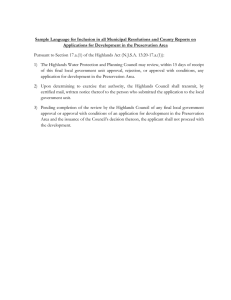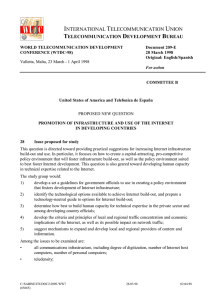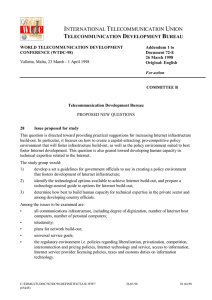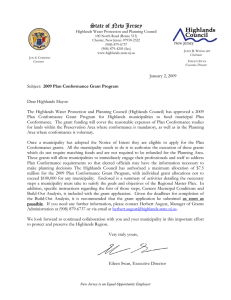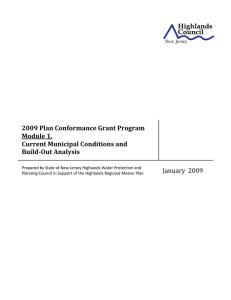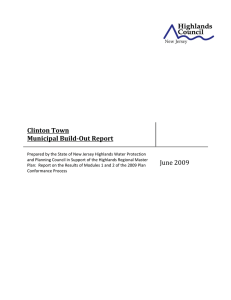HIGHLANDS MUNICIPAL BUILD-OUT REPORT FREQUENTLY ASKED QUESTIONS
advertisement
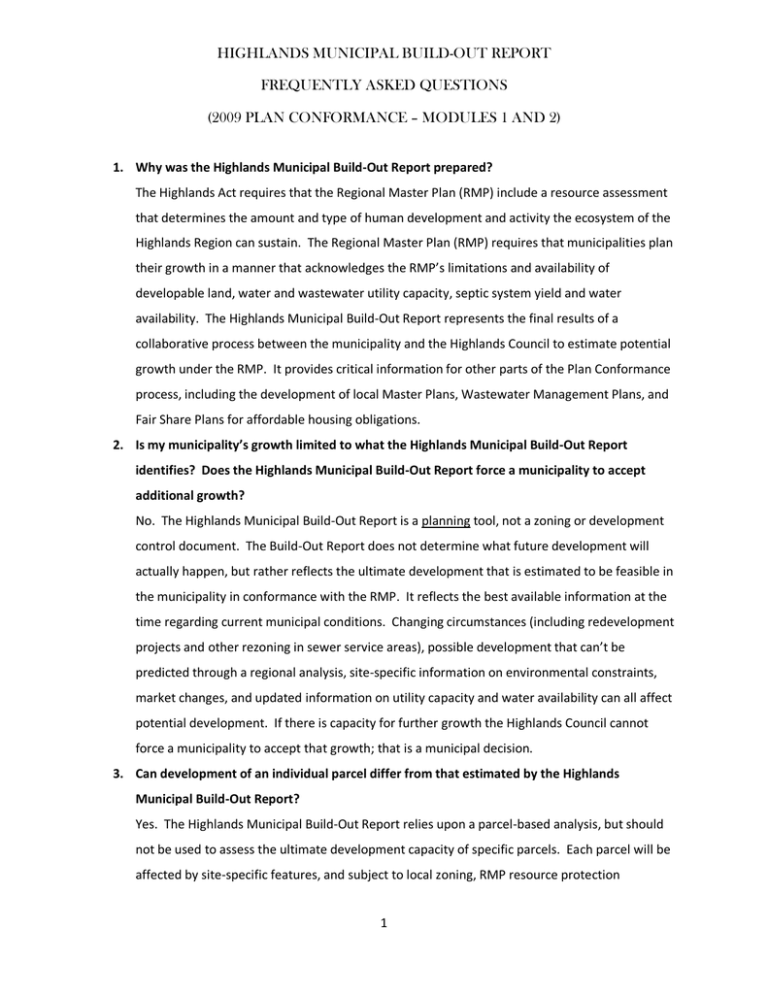
HIGHLANDS MUNICIPAL BUILD-OUT REPORT FREQUENTLY ASKED QUESTIONS (2009 PLAN CONFORMANCE – MODULES 1 AND 2) 1. Why was the Highlands Municipal Build-Out Report prepared? The Highlands Act requires that the Regional Master Plan (RMP) include a resource assessment that determines the amount and type of human development and activity the ecosystem of the Highlands Region can sustain. The Regional Master Plan (RMP) requires that municipalities plan their growth in a manner that acknowledges the RMP’s limitations and availability of developable land, water and wastewater utility capacity, septic system yield and water availability. The Highlands Municipal Build-Out Report represents the final results of a collaborative process between the municipality and the Highlands Council to estimate potential growth under the RMP. It provides critical information for other parts of the Plan Conformance process, including the development of local Master Plans, Wastewater Management Plans, and Fair Share Plans for affordable housing obligations. 2. Is my municipality’s growth limited to what the Highlands Municipal Build-Out Report identifies? Does the Highlands Municipal Build-Out Report force a municipality to accept additional growth? No. The Highlands Municipal Build-Out Report is a planning tool, not a zoning or development control document. The Build-Out Report does not determine what future development will actually happen, but rather reflects the ultimate development that is estimated to be feasible in the municipality in conformance with the RMP. It reflects the best available information at the time regarding current municipal conditions. Changing circumstances (including redevelopment projects and other rezoning in sewer service areas), possible development that can’t be predicted through a regional analysis, site-specific information on environmental constraints, market changes, and updated information on utility capacity and water availability can all affect potential development. If there is capacity for further growth the Highlands Council cannot force a municipality to accept that growth; that is a municipal decision. 3. Can development of an individual parcel differ from that estimated by the Highlands Municipal Build-Out Report? Yes. The Highlands Municipal Build-Out Report relies upon a parcel-based analysis, but should not be used to assess the ultimate development capacity of specific parcels. Each parcel will be affected by site-specific features, and subject to local zoning, RMP resource protection 1 HIGHLANDS MUNICIPAL BUILD-OUT REPORT FREQUENTLY ASKED QUESTIONS (2009 PLAN CONFORMANCE – MODULES 1 AND 2) requirements, and various other regulatory requirements that were not assessed at the municipal or regional level. 4. How were potential build-out candidate parcels identified? All of the parcels identified as potential candidates for inclusion in the build-out process (vacant, over-sized or redevelopable areas) were identified in partnership with the professionals working for each municipality under the 2009 Plan Conformance Grant. The Highlands Council processing of these parcels does not result in any additions, though it may have resulted in reductions. The answers to Questions 5, 8 and 9 provide information on how parcels originally identified as potential build-out candidates may have failed to be considered for build out in the final analysis. 5. What makes a parcel a potential build-out candidate? The potential developable parcel candidates identified by the municipality were evaluated by the Highlands Council in the build-out model to determine if they meet the criteria of the RMP for available land and utility conditions. 6. What is the time period associated with the Highlands Municipal Build-Out Report? The Highlands Municipal Build-Out Report evaluates the complete build out of potential developable lands from 2009 on in accordance with the RMP. Because the Report reflects the full build out based on current conditions, it does not have a forecast end date associated with the analysis. 7. What is the difference between how parcels in the Preservation versus the Planning Areas were addressed? Parcels in the Preservation Area are evaluated in accordance with both the Preservation Area criteria in the Highlands RMP and NJDEP’s Highlands Preservation Area Rules at N.J.A.C. 7:38 (which were incorporated by reference in the RMP). Parcels in the Planning Area are evaluated solely in accordance with the Highlands RMP criteria for the Planning Area. 8. Why are some parcels identified as having water or waste water utilities and others do not? For a Planning Area parcel to be considered for service by a RMP Wastewater or Public Water Utility Area, it must have been identified by the municipality as a potential candidate for build out in a previously approved sewer service area and have at least a 1400 sq. ft. of Existing 2 HIGHLANDS MUNICIPAL BUILD-OUT REPORT FREQUENTLY ASKED QUESTIONS (2009 PLAN CONFORMANCE – MODULES 1 AND 2) Community Zone (ECZ) or Lake Community Sub-Zone (LCZ); these are the only two areas where sewer service extensions are routinely allowed by the RMP. The area threshold is used to eliminate substandard lots that could only be built upon municipal approval of a variance. All other candidate parcels are considered as part of the septic system yield process in the model. In the Preservation Area, a parcel must be included in the NJDEP sewer service area, which was modified and limited by the Highlands Act requirements. 9. How is my municipal zoning factored into the Highlands Municipal Build-Out Report? Municipal zoning density (in residential dwelling units per acre, or “DU/Acre”) and intensity (in non-residential floor area ratio, or “FAR”) values apply only to those parcels acceptable under the RMP for sewer build-out (as discussed above). For some lots, this analysis is limited to the Existing Community Zone or Lake Community Zone developable area of the parcel (i.e., any other part of the parcel is included in the septic system yield analysis). A parcel must have at least 1400 sq. ft of developable area (excluding the RMP Build-out Environmental constraints of steep slopes, flood plain/floodprone areas and Highlands Open Water buffers) and meet the municipal zoning criteria in order to be a final sewer build-out candidate. For example, oversized residential lots (where the lot is greater than the zoned minimum) must have sufficient acreage to accommodate at least 1 new residential unit. Again, all other parcels are considered as part of the septic system build-out process in the model. 10. Why isn’t municipal zoning used to determine septic system yield? The septic system yield analysis in the Municipal Build-Out Report is based on RMP requirements for septic system densities, as applied to the total acreage of potential developable land in the Preservation Area (based on the NJDEP Preservation Area rules), and in the Planning Area for each Land Use Capability Zone (i.e., Protection, Conservation, and Existing Community, with each Zone including any relevant sub-zones) within each HUC14 subwatershed. The RMP uses a different nitrate target in the Planning Area for each of the three major Land Use Capability Zones (Protection Zone, Conservation Zone and Existing Community Zone). Municipal zoning density requirements generally are not in conformance with the RMP, and therefore are not used in this analysis. 3 HIGHLANDS MUNICIPAL BUILD-OUT REPORT FREQUENTLY ASKED QUESTIONS (2009 PLAN CONFORMANCE – MODULES 1 AND 2) 11. My town may have parcels eligible for exemption from the Highlands Act. How are they taken into account? The analysis used in developing the Highlands Municipal Build-Out Report does not explicitly include potential Highlands Act Exemptions in either the Preservation or Planning Areas. However, the septic system and sewer build-out analyses may include parcels that would also be eligible for Highlands Act exemptions. For instance, all vacant parcels that are not assessed in the build out as being in a sewer service area are included in the septic system yield analysis, so potential exempt parcels do contribute to septic system yield. Likewise, the analysis does not address directly any identified developable condominium parcels, or projects that received a Certificate of Occupancy (CO) after January of 2009. It is important to note that any project or activity eligible for an exemption under the Highlands Act is therefore exempt from the NJDEP Preservation Area rules, the Regional Master Plan, and any regulatory provisions adopted by municipalities and counties under Plan Conformance. Therefore, it would be inappropriate for a build-out analysis based on conformance with the Highlands Act and Regional Master Plan to address the implications of exemptions. 12. How does the Highlands Municipal Build-Our Report factor in future land use changes at various levels of planning? How can a redevelopment area not presently included be approved? The Highlands Municipal Build-Out Report model does not identify potential redevelopment opportunities beyond those currently available or known under existing zoning for over-sized parcels, nor development opportunities that may be approved through variances (e.g., for substandard lots). In the Preservation Area and some parts of the Planning Area, approval by the Highlands Council of a Highlands Redevelopment Area will be necessary for redevelopment projects to move forward; this would not be necessary in the Existing Community Zone of the Planning Area. The Report does not address potential future changes in land use category (e.g., commercial to residential) through redevelopment. A municipality can plan for and track these activities separately. 4 HIGHLANDS MUNICIPAL BUILD-OUT REPORT FREQUENTLY ASKED QUESTIONS (2009 PLAN CONFORMANCE – MODULES 1 AND 2) 13. The municipality identified a parcel as currently being served by either water or wastewater utilities, so why does the map still show it as not being served? The maps show the service areas as mapped in the 2008 RMP. While new information from the RMP Municipal Build-out was factored into the build-out analysis as appropriate, this information does not represent a formal RMP Update or a change to the 2008 RMP information. The information in Module 1 and 2 supports the understanding of municipal conditions in support of Basic Plan Conformance. RMP Updates are required for factual updates to the 2008 RMP, and will be processed through a separate procedure that includes formal verification of conditions. After completion of this procedure, the RMP maps will be modified as appropriate. 14. Are the environmental constraints shown in the Highland Municipal Build-Our Report all of the environmental constraints in the RMP? The environmental constraints shown on Figure 2 of the Highlands Municipal Build-Out Report reflect Highlands Open Waters and their buffers, steep slopes and flood plains/flood hazard areas. The RMP includes requirements for other environmental constraints not shown on Figure 2, which may have a significant effect on where development may be sited or how development is designed. 15. How does the municipal wastewater and public water utility capacity information affect the Highlands Municipal Build-Out Report? The public water supply and wastewater demands of development projected for the utility service area are compared to the utility capacity available to the municipality, regarding both public water supply and wastewater utilities. Where capacity is insufficient to support the buildout demand, the build-out estimates are reduced. Residential and non-residential development are both reduced by the same percentage. 16. How does the Highlands Council evaluate water availability for the Highlands Municipal BuildOut Report? The water supply demands resulting from build out in both public water supply utility service areas and domestic well service areas are compared to the Net Water Availability for the HUC14 subwatershed. In many cases, this step required information regarding water supply demands from other municipalities, so that the full demands from each HUC14 subwatershed could be 5 HIGHLANDS MUNICIPAL BUILD-OUT REPORT FREQUENTLY ASKED QUESTIONS (2009 PLAN CONFORMANCE – MODULES 1 AND 2) assessed. Again, where Net Water Availability is insufficient to support the build-out demand, the build-out estimates are reduced. Build-out results in sewer service areas are reduced first, with residential and non-residential development being reduced by the same percentage. If these reductions are insufficient to resolve the shortfall, the septic system build-out results are reduced to the extent necessary. 17. Can a municipality use excess utility capacity? If a wastewater utility had available capacity for a municipality after meeting all build-out demands, there may or may not be sufficient water availability to actually support development. The Highlands Council investigated whether sufficient Net Water Availability exists to support the use of all or part of that wastewater utility capacity. The results are in the Highlands Municipal Build-Out Report. Where both utility capacity and water availability exist, the municipal may determine whether and how to use that capacity for such municipally-desired purposes as affordable housing, TDR Receiving Zones, redevelopment and other purposes, where consistent with the RMP. 18. How does a municipality zone to address the available septic system yield identified by the Highlands Municipal Build-Out Report? Municipalities will address the septic system yield in two steps. Under Basic Plan Conformance, they will adopt an ordinance requiring that septic system yield be determined for each development project that is regulated under the RMP. Later, the municipalities will conduct further planning and then modify zoning to ensure that the new septic systems from all eligible parcels in a subwatershed do not exceed the septic system yield for that subwatershed. 19. How can I use the build-out information to see how a specific parcel was treated? The Highlands Council provided the geodatabase which can be used with ArcGIS®. For convenience, the Highlands Council also provided the same database which can be used with Microsoft Excel®. Specific parcels can be found searching by block and lot. 20. Where can I find all the information used to in the build-out analysis? All the information used in the development of the Highlands Municipal Build-Out Report for a municipality is available for download on the Highlands Council’s website 10 business days after delivery to the municipality. This includes the final Report, letter and plotter sized maps, parcel6 HIGHLANDS MUNICIPAL BUILD-OUT REPORT FREQUENTLY ASKED QUESTIONS (2009 PLAN CONFORMANCE – MODULES 1 AND 2) based geodatabase to be used with GIS software, and a Microsoft Excel® spreadsheet of the parcel-based geodatabase. Please note that when the final Report is issued, it represents all work performed under Module 1 and Module 2, and supersedes all draft products developed under Module 1. 21. How can a municipality seek an amendment to the Highlands Municipal Build-Out Report? The Highlands Municipal Build-Out Report is a snapshot in time. Because it is a planning tool, rather than a regulatory document, it does not need to be continually updated. Therefore, each Report is considered final. Future planning work may require the development of a new Highlands Municipal Build-Out Report for specific municipalities, but the Highlands Council does not anticipate the need for a new series of Reports in the near future, nor does it plan to provide modified Reports at this time. However, if a municipality identifies a problem with the analysis that would result in a significant change in the build-out results, the municipality may bring this issue to the attention of the Highlands Council. Likewise, if the Highlands Council identifies a significant problem, it may revise the Municipal Build-Out Report and will notify the municipality of the need to do so. 7
